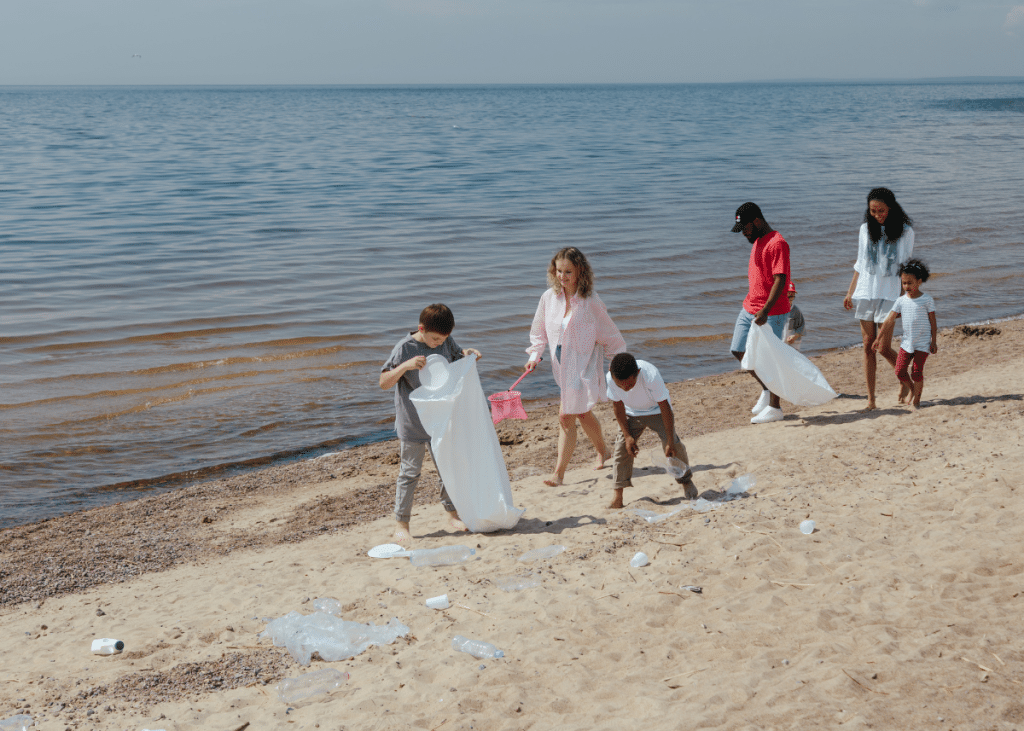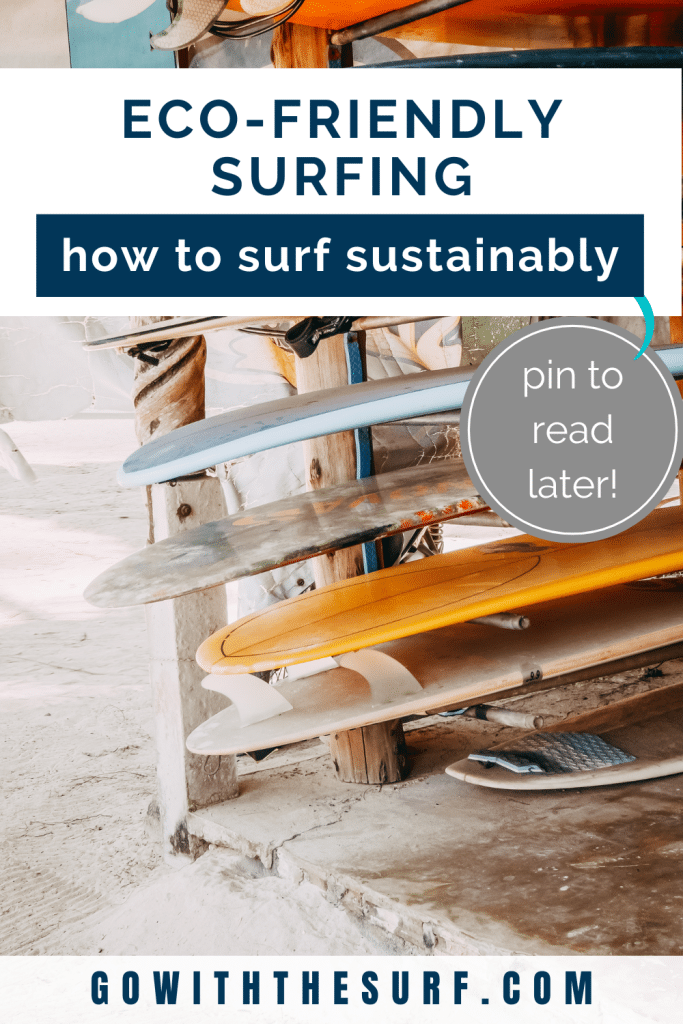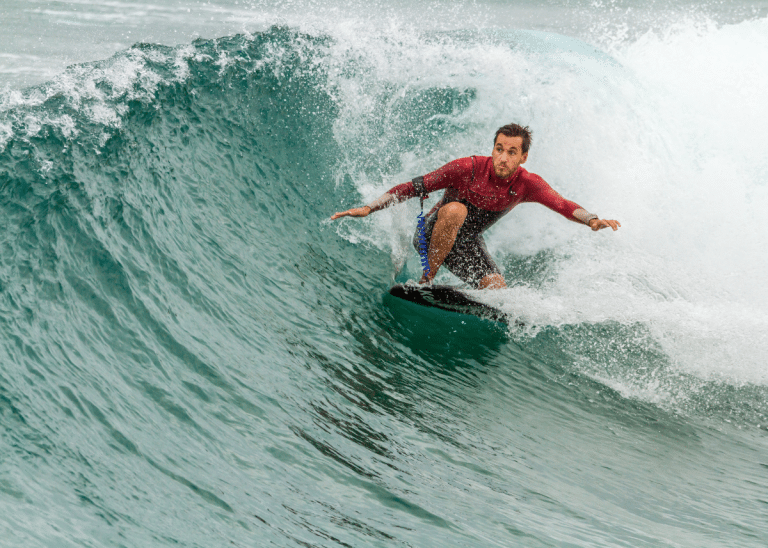Eco-Friendly Surfing: Sustainable Waves for the Future
When I started surfing last year, my surf instructor told me, “You’re going to fall twice: in the water and then in love.” And nothing could be more true!
But as I fall more in love with surfing with each ride, I am hoping that my 2 small kids can also enjoy the beach and waves when they are older.
While us surfers are enjoying the water, it’s important to consider the impact that surfing has on the environment. This is where eco-friendly surfing comes in!
Eco-friendly surfing is a movement that aims to minimize harm to our oceans and beaches while enjoying the waves.
But what does eco-friendly surfing entail? You’ll be surprised at all the ways that surfers can surf responsibly so that our future generations can also enjoy the waves!
This post contains affiliate links, which means I receive a small commission, at no extra cost to you, if you make a purchase using this link. Please see my disclosure for more details.
Choose Eco-Friendly Gear for Surfing
Selecting the right gear helps reduce your environmental impact and supports sustainable practices. This way, you not only contribute to preserving the oceans but also promote ethical manufacturing processes. Here are two essential aspects to consider when choosing eco-friendly gear:
Select Sustainable Materials
Opt for products crafted from environmentally friendly materials. This helps reduce your carbon footprint and supports a healthier planet. Some examples of sustainable materials used in eco-friendly surf gear include:
- Recycled Polyester: Utilized in wetsuits, board shorts, and accessories.
- Yulex: A plant-based alternative to neoprene used in wetsuits.
- Bamboo: Found in surfboard constructions for its durability and eco-friendliness.
- Econyl: A regenerated nylon made from recycled materials used in surf apparel.
Support Sustainable Brands
Choose brands that prioritize sustainability and ethical practices. This is another way to make a positive impact with your purchasing decisions. By supporting eco-friendly brands, you encourage the industry to adopt more sustainable production practices. Your purchasing choices send a powerful signal that customers value environmentally responsible methods. Here are some brands that prioritize sustainability in their surf gear:
- Patagonia: Known for its commitment to environmental activism and sustainable products.
- Billabong: Offers a range of eco-friendly wetsuits and surf apparel.
- Dakine: Produces accessories and gear using recycled materials.
- Futures: Known for innovative fins made from sustainable materials.

Responsible Waste Management
Surfers who care about the ocean know that properly throwing away old surfboards and other gear is important for protecting marine life. By taking part in beach cleanups and conservation efforts, surfers can make a real difference in keeping oceans healthy.
Proper Disposal of Surf Gear
When it’s time to say goodbye to your trusty surfboard or wetsuit, consider these responsible disposal tips:
- Look for recycling programs or dedicated drop-off locations for surf gear.
- Donate usable gear to surf schools or organizations that can repurpose them.
- Avoid throwing old gear into regular trash bins to prevent unnecessary waste.
Participate in Conservation Efforts
Now that our family lives by the ocean in Portugal, we encourage our children to participate in local beach clean-ups. Engaging in beach clean-ups and supporting organized conservation initiatives are a great way to get involved.
- Beach clean-ups help remove harmful debris like plastic waste that threatens marine life.
- Conservation efforts such as mangrove restoration or reef protection contribute to preserving natural habitats.
- Joining local environmental groups or surf clubs often leads to community-driven initiatives that benefit coastal areas.
By adopting these waste management practices and actively participating in conservation efforts, surfers can embody the principles of eco-friendly surfing and contribute to the protection of our oceans and beaches.

Minimize Your Carbon Footprint
As a surfer, embracing eco-friendly practices is a great way to protect the waters you love. By minimizing your carbon footprint, you can contribute to preserving the marine environment for future generations.
Transportation Choices
When heading to the beach for a day of surfing, consider carpooling with friends or using public transportation. When we moved from the United States to Portugal last year, we opted to not have a car and instead use the available public transportation.
By sharing rides or opting for buses, trains, or bicycles, you reduce carbon emissions and traffic congestion. These small changes can make a big difference in reducing your environmental impact.
Eco-Friendly Sunscreen
Traditional sunscreens contain harmful chemicals like oxybenzone and octinoxate. These pose a threat to coral reefs and marine life. Choose eco-friendly sunscreen options that are mineral-based and reef-safe. Look for products labeled as “reef-friendly”. This will protect the delicate ecosystem beneath the waves while enjoying your time in the sun.

Support Local Communities and Ecosystems
Another way to preserve the beauty of our oceans and beaches is to support local communities and ecosystems. By shopping locally and respecting wildlife, surfers can make a proactive impact on the environment while enjoying their favorite sport.
Shop Locally
When you choose to shop locally for your surf gear and souvenirs, you are not just making a purchase. You are investing in the livelihoods of small businesses within the community. This way, you contribute to the sustainability of the local economy and reduce the carbon footprint associated with shipping products over long distances. Opting for eco-friendly products from local brands can also ensure that your purchases align with ethical and sustainable practices, further promoting eco-conscious surfing practices.
Respect Wildlife
As a surfer, it’s crucial to interact responsibly with wildlife and marine ecosystems during your surfing adventures. Simple actions such as avoiding nesting areas, giving wildlife ample space, and refraining from feeding marine animals can help protect the delicate balance of marine life.
Additionally, being mindful of your waste and picking up any trash you come across on the beach can prevent pollution and safeguard the habitats of coastal wildlife. By respecting wildlife and marine ecosystems, you contribute to the preservation of our oceans for future generations of surfers to enjoy.

FAQs about Eco-Friendly Surfing
What is eco-friendly surfing?
Eco-friendly surfing involves using products and practices that minimize harm to the environment. This includes biodegradable waxes, recycled or sustainable materials for surfboards, and supporting local businesses that adhere to environmental standards.
Can I make my current surfing more sustainable without buying new gear?
Absolutely! Start by taking care of your existing equipment to extend its lifespan. Use eco-friendly wax, and always collect your trash and any other litter you might find at the beach.
What should I look for in an eco-friendly surf wax?
Choose surf waxes that are labeled as non-toxic and biodegradable. These waxes avoid petroleum-based ingredients, opting instead for natural components like beeswax or coconut oil.
How can I get involved in ocean conservation as a surfer?
Participate in or organize beach clean-ups, support bans on single-use plastics, and educate others about the importance of protecting our oceans. Engaging with local environmental groups and initiatives can amplify your impact.
How can I find an eco-friendly surfboard?
Look for boards made from recycled materials or sustainable woods like bamboo. Many manufacturers now offer “green” boards that use less toxic resins and recycled polystyrene.

Eco-Friendly Surfing for a Better Future
Isn’t it surprising how many ways us surfers can contribute to eco-friendly surfing?! Eco-friendly surfing is not only a way to enjoy the waves and connect with nature. It’s also a great way to protect our oceans and marine life for our kids, grandkids, great-grandkids, etc.
What eco-friendly surfing practice will you start to implement today?

Anh
Anh recently retired at the age of 35 and moved to a small surf town in Portugal in 2023. She started surfing as a hobby, but she fell in love with the water sport. She shares her tips and tricks with fellow surfers at Go With the Surf.










